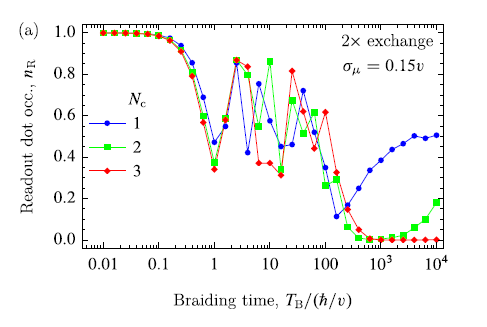Braiding-based quantum control of a Majorana qubit built from quantum dots
Péter Boross1, and András Pályi2,3
1 Faulhorn Labs, Budafoki út 91-93, H-1117 Budapest, Hungary
2 Department of Theoretical Physics, Institute of Physics, Budapest University of Technology and Economics, Műegyetem rkp. 3., H-1111 Budapest, Hungary
3 MTA-BME Quantum Dynamics and Correlations Research Group, Műegyetem rkp. 3., H-1111 Budapest, Hungary
Topology-related ideas might lead to noise-resilient quantum computing. For example, it is expected that the slow spatial exchange (`braiding') of Majorana zero modes in superconductors yields quantum gates that are robust against disorder. Here, we report our numerical experiments [1], which describe the dynamics of a Majorana qubit built from quantum dots controlled by time-dependent gate voltages [2,3,4]. Our protocol incorporates non-protected control, braiding-based protected control, and readout, of the Majorana qubit. We use the Kitaev chain model [5] for the simulations, and focus on the case when the main source of errors is quasistatic charge noise affecting the hybridization energy splitting of the Majorana modes [6,7]. We provide quantitative guidelines to suppress both diabatic errors and disorder-induced qubit dephasing, such that a fidelity plateau is observed as the hallmark of the topological quantum gate. Our simulations predict realistic features expected in future braiding experiments with Majorana zero modes in quantum-dot-based devices [8].
This research was supported by the Ministry of Culture and Innovation of Hungary and the National Research, Development and Innovation Office (NKFIH) within the Quantum Information National Laboratory of Hungary (Grant No. 2022-2.1.1-NL-2022-00004), and by the NKFIH via the OTKA Grant No. FK 132146.
[1] P. Boross, A. Pályi, to be submitted.
[2] M. Leijnse, K. Flensberg, Phys. Rev. B 86, 134528 (2012).
[3] I. C. Fulga et al., New J. Phys. 15 045020 (2013).
[4] J. D. Sau and S. Das Sarma, Nat. Comm. 3, 964 (2012).
[5] A. Yu. Kitaev, Phys.-Usp. 44, 131 (2001).
[6] G. Széchenyi, A. Pályi, Phys. Rev. B 101, 235441 (2020).
[7] V. D. Maman, F. M. Gonzalez-Zalba, A. Pályi, Phys. Rev. Applied 15, 064024 (2020).
[8] T. Dvir et al., https://arxiv.org/abs/2206.08045.

Figure 1. Numerical demonstration of topological protection of the braiding-based quantum-logical gate. Readout dot charge occupation as a function of the braiding time, for various system sizes (Nc). With increased system size (Nc = 3), a plateau emerges for long braiding times, signalling topological protection of the braiding-based quantum logical gate.